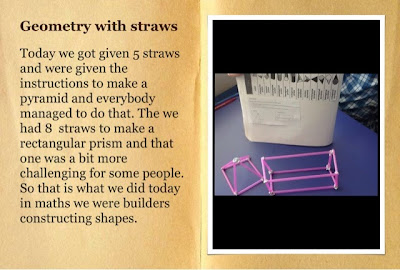Room4@StM
Tuesday, 25 November 2014
Monday, 24 November 2014
Tuesday, 18 November 2014
Thursday, 13 November 2014
Camp Tutira
The students in room 4 enjoyed a fantastic camp at Tutira early this week. The weather was warm and settled so we could make the most of all the outdoor activities available. It was a very busy and physically challenging camp for both students and adults. Sometimes we had to go out of our own personal comfort zone but all of us participated in the end.
We had excellent parent support on the camp. Many thanks to Brendon, John, James, Kim, Dale, Steph, Anna and Rachael. Without their help and support, the camp would not have run so smoothly.
Thank you to the staff at Camp Tutira also. Thank you to Lynne who showed the children around the Arboretum. Thank you to Kirsty who took us on the famous mud walk and made sure we had everything we needed. Thank you to Ryan, the Outdoor Education Instructor, who kept us safe and motivated during the outdoor activities.
Please enjoy our photos.
(Unfortunately there are no photos of the mud walk, canoeing or the night-line walk).
(Unfortunately there are no photos of the mud walk, canoeing or the night-line walk).
 |
| Lynne took us around the Arboretum. She is a powerhouse of knowledge. |
 |
| Beautiful Lake Tutira. |
 |
 |
 |
 |
| The Weta Hotel! |
 |
 |
| Feeding the pig. Can you spot the piglet? |
 |
 |
 |
 |
| Team building activities with Ryan. |
 |
 |
 |
| The Flying Kiwi! |
 |
 |
| The on-ground support team. |
 |
 |
| Flying high! |
 |
 |
 |
 |
| Nat has a go too. |
 |
 |
 |
 |
Friday, 7 November 2014
Crazy about Cranes
Sadako Sasaki was a girl who got sick due to the nuclear bomb explosion in Hiroshima, Japan. Her friend told her that if she made 1000 cranes she could make a wish.
Sadly she died at the age of twelve but managed to make 644.
Sadly she died at the age of twelve but managed to make 644.
Today in class we each made a row of how many cranes we could make. Everyone managed to make at least 5. There were definitely some experts!
Children found it fun but also challenging. The children helped each other to make the cranes. It was excellent teamwork.
Children found it fun but also challenging. The children helped each other to make the cranes. It was excellent teamwork.
Mrs Hutcheson had to make many square sized pieces of paper!
This origami project is part of our study about Japan.
For each crane that was made, the children were encouraged to think about Sadako. In the end the class made over 300 cranes.
For each crane that was made, the children were encouraged to think about Sadako. In the end the class made over 300 cranes.
 |
| Beautiful words from Lily. |
 |
| Isabelle holds up a string of completed cranes. |
 |
| Ella persists … |
 |
| Flynn is working well making his cranes. |
 |
| Samuel made the smallest and largest crane in the class. He's definitely an expert! |
 |
| A miniature crane. |
 |
 |
| A bag of completed cranes from Keelan and Samuel. |
 |
| Lochy concentrates hard! |
 |
| Nice team work girls! |
Thursday, 6 November 2014
Chelsea Sugar Company Challenge
Mrs Hutcheson gave some students in room 4 a challenge. The Chelsea Sugar Company wanted a new design to package their sugar cubes.
The packaging must hold 40 sugar cubes, and there must be no gaps in the packet.
The students used cubes to test their packaging.
This activity involves learning about volume in maths.
V = L X W X H
Monday, 3 November 2014
The Writing Process
The writing process is very complex. The students in room 4 are learning about explanation writing. Obviously this writing explains something.
Mrs Hutcheson, a Candidate Teacher who is teaching in room 4, used a science based experiment involving balloons as a topic for explanation writing. Here are photos showing some of the steps involved.
Mrs Hutcheson, a Candidate Teacher who is teaching in room 4, used a science based experiment involving balloons as a topic for explanation writing. Here are photos showing some of the steps involved.
 |
 |
| Lots of discussion helps the students to draw on their prior knowledge and share ideas. |
 |
| Time to come back to class to share ideas. |
 |
| This is a list of keywords from the students about the topic. This list supports the children when they write. |
 |
| Here is Lily's example of predicting what she thinks will happen. |
 |
| The balloons are ready… The rules are explained by Mrs Hutcheson … |
 |
| The yellow balloon had another balloon inside it that was filled with water. We talked about how it felt and sounded. The balloon acted in a strange way. |
 |
 |
| We wrote down our ideas to help us in our writing later. |
 |
| We threw the balloon and really tested it. It proved difficult to pop! |
 |
 |
| Alice tries her bowling skills on the balloon. It remains intact. |
 |
| The experiment has ended. We are allowed to burst the balloon. This pink balloon was very stubborn. |
 |
| We are back inside now and sharing ideas about what we found. We add this information in our writing book. |
 |
 |
 |
 |
| Mrs Hutcheson shares some examples of great work. Well done Rubi for drawing a diagram to record and explain your thinking. Well done Lily for using bullet points to list her ideas and experience. |
 |
Subscribe to:
Comments (Atom)








